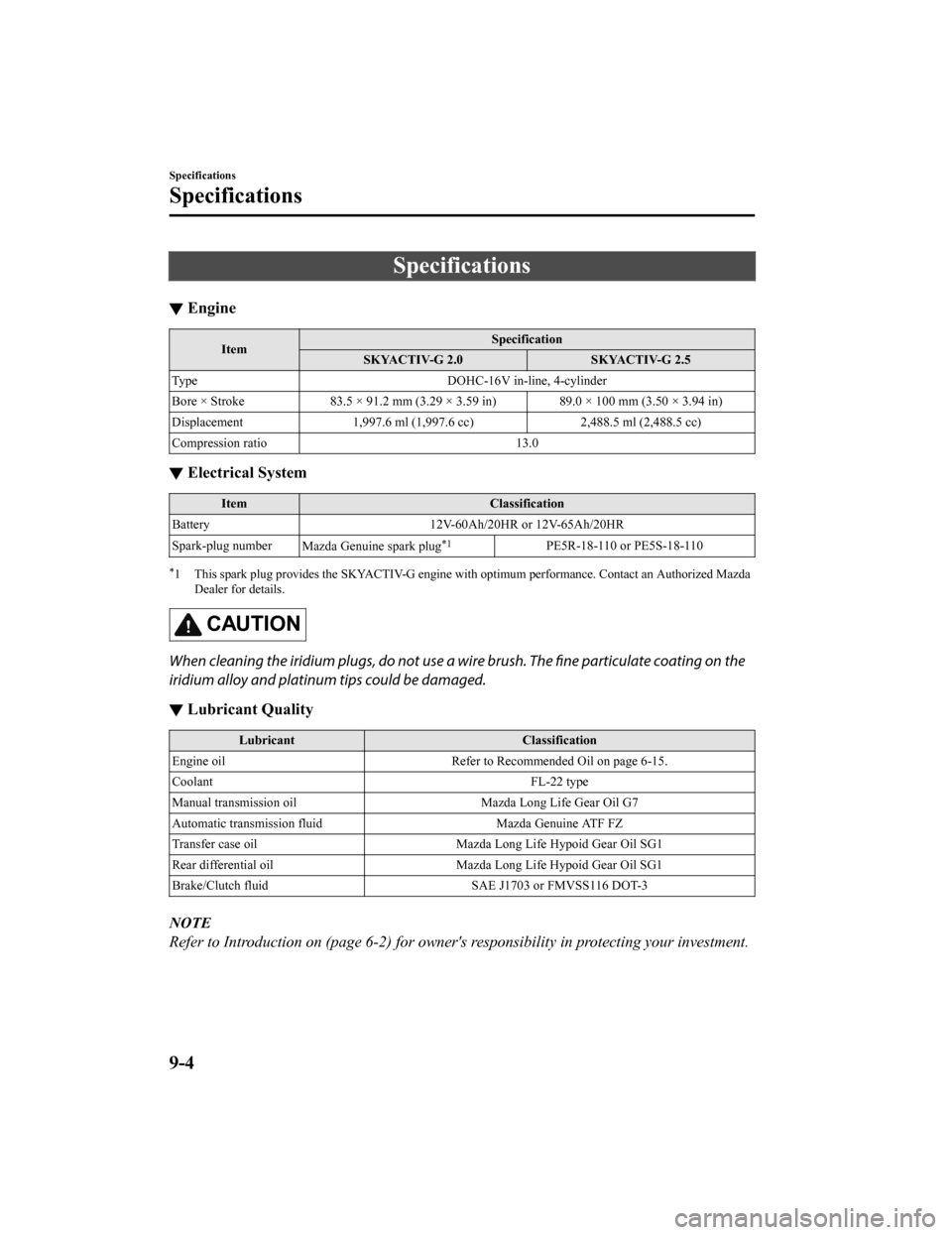ESP MAZDA MODEL 3 HATCHBACK 2020 (in English) Service Manual
[x] Cancel search | Manufacturer: MAZDA, Model Year: 2020, Model line: MODEL 3 HATCHBACK, Model: MAZDA MODEL 3 HATCHBACK 2020Pages: 598, PDF Size: 89.37 MB
Page 562 of 598

7. Repeat with each tire, including thespare.
NOTE
Some spare tires require higher
inflation pressure.
8. Visually inspect the tires to make sure
there are no nails or other objects
embedded that could poke a hole in the
tire and cause an air leak.
9. Check the sidewalls to make sure there are no gouges, cuts, bulges, cracks or
other irregularities.
▼Glossary of Terms
Tire Placard:
A label indicating the OE
tire sizes, recommended inflation pressure,
and the maximum weight the vehicle can
carry.
Tire Identification Number (TIN): A
number on the sidewall of each tire
providing information about the tire brand
and manufacturing plant, tire size, and
date of manufacture.
Inflation Pressure: A measure of the
amount of air in a tire.
kPa: Kilopascal, the metric unit for air
pressure.
psi: Pounds per square inch, the English
unit for air pressure.
B-pillar: The structural member at the
side of the vehicle behind the front door.
Original Equipment (OE): Describes
components originally equipped on the
vehicle.
Vehicle Load Limit: The maximum value
of the combination weight of occupants
and cargo.
Bead Area of the Tire: Area of the tire
next to the rim.
Sidewall Area of the Tire: Area between
the bead area and the tread.
Tread Area of the Tire: Area on the
perimeter of the tire t hat contacts the road
when it's mounted on the vehicle.
Seating capacity means the total
allowable number of vehicle occupants.
Seating capacity is described on the tire
label.
Production options weight is the
combination weight of installed regular
production options weighing over 2.3
kilograms in excess of the standard items
which they replace, and not previously
considered in the curb weight or accessory
weight, including heavy duty brakes, ride
levelers, roof rack, heavy duty battery, and
special trim.
Rim is the metal support (wheel) for a tire
or a tire and tube assembly upon which the
tire beads are seated.
Customer Information and Reporting Safety Defects
Tire Information (U.S.A.)
8-28
Mazda3_8HZ1-EA-19G_Edition1_old 2019-5-17 13:49:03
Page 565 of 598

Vehicle Loading
▼Vehicle Loading
WA R N I N G
Do not tow a trailer with this vehicle:
Towing a trailer wi
th this vehicle is
dangerous because it has not been
designed to tow a trailer and doing so will
affect the drive system which could result in
vehicle damage.
This section will guide you in the proper
loading of your vehicle, to keep your
loaded vehicle weight within its design
rating capability. Properly loading your
vehicle will provide maximum return of
vehicle design performance. Before
loading your vehicle, familiarize yourself
with the following terms for determining
your vehicle's weight ratings, from the
vehicle's Safety Certification Label and
Tire and Load Information Label:
WA R N I N G
Overloaded Vehicle:
Overloading a vehicle is dangerous. The
results of overloading can have serious
consequences in terms of passenger safety.
Too much weight on a vehicle's suspension
system can cause spring or shock absorber
failure, brake failure, handling or steering
problems, irregular tire wear, tire failure or
other damage.
Overloading makes a vehicle harder to
drive and control. It also increases the
distance required for stopping. In cases of
serious overloading, brakes can fail
completely, particularly on steep grades.
The load a tire will carry safely is a
combination of the size of the tire, its load
range, and corresponding inflation
pressure.
Never overload the vehicle and always
observe the vehicle's weight ratings from
the vehicle's Safety Certification and Tire
and Load Information labels.
Base Curb Weight is the weight of the
vehicle including a f ull tank of fuel and
all standard equip ment. It does not
include passengers, cargo, or optional
equipment.
Vehicle Curb Weight is the weight of
your new vehicle when you picked it up
from your dealer plus any aftermarket
equipment.
PAYLOAD
Customer Information and Reporting Safety Defects
Tire Information (U.S.A.)
8-31
Mazda3_8HZ1-EA-19G_Edition1_old 2019-5-17 13:49:03
Page 582 of 598

Specifications
▼Engine
Item Specification
SKYACTIV-G 2.0 SKYACTIV-G 2.5
Type DOHC-16V in-line, 4-cylinder
Bore × Stroke 83.5 × 91.2 mm (3.29 × 3.59 in) 89.0 × 100 mm (3.50 × 3.94 in)
Displacement 1,997.6 ml (1,997.6 cc) 2,488.5 ml (2,488.5 cc)
Compression ratio 13.0
▼Electrical System
Item
Classification
Battery 12V-60Ah/20HR or 12V-65Ah/20HR
Spark-plug number Mazda Genuine spark plug
*1PE5R-18-110 or PE5S-18-110
*1 This spark plug provides the SK YACTIV-G engine with optimum performance. Contact an Authorized Mazda
Dealer for details.
CAUTION
When cleaning the iridium plugs, do not use a wire brush. The fine particulate coating on the
iridium alloy and platinum tips could be damaged.
▼ Lubricant Quality
Lubricant
Classification
Engine oil Refer to Recommended Oil on page 6-15.
Coolant FL-22 type
Manual transmission oil Mazda Long Life Gear Oil G7
Automatic transmission f luid Mazda Genuine ATF FZ
Transfer case oil Mazda Long Life Hypoid Gear Oil SG1
Rear differential oil Mazda Long Life Hypoid Gear Oil SG1
Brake/Clutch fluid SAE J1703 or FMVSS116 DOT-3
NOTE
Refer to Introduction on (page 6-2) for owner's responsibility in protecting your investment.
Specifications
Specifications
9-4
Mazda3_8HZ1-EA-19G_Edition1_old 2019-5-17 13:49:03